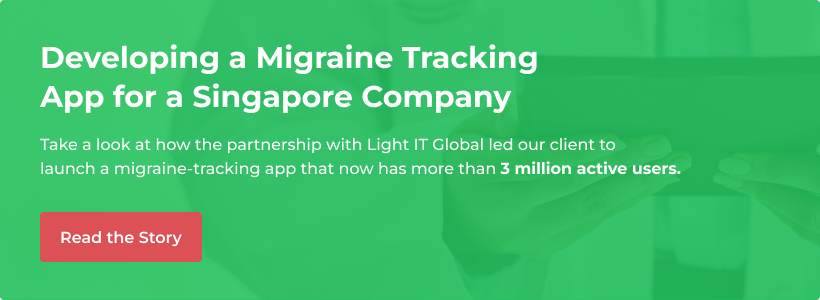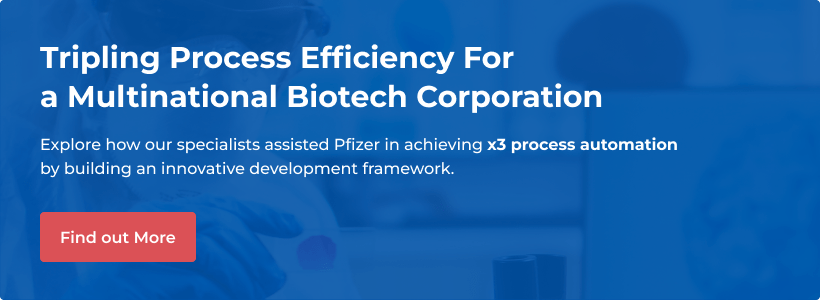Modern healthcare is one of the industries adopting the latest technological advancements at a rapid speed and proving that digitalization benefits not only transnational corporations but small local companies as well. It’s also one of the business niches where the percentage of web-based software remains relatively high despite the growing popularity of mobile solutions. So it won’t be a stretch to assume that even though mobile software evolves swiftly and smartphones turn out to be “smarter” day by day, healthcare web development is not going anywhere.
The web-based software creation is a necessity for almost all types of healthcare-related businesses. No market success or audience recognition is achievable without it. So despite the process being nuanced and time-consuming, an entrepreneur eventually has to get over the anxiety and pursue building the first custom web-based solution.
To make this journey easier and, hopefully, more pleasant, Light IT Global has created a guide containing all the relevant info regarding healthcare web development. In a single editorial, we’ve gathered tips and insights about the industry trends, types of solutions favored by the audience, as well as the step-by-step algorithm of software production and pricing.
Top 5 healthcare technology trends to keep your eye on
Keeping up with the freshest tendencies in the technology world has become one of the main ingredients in the recipe for success for many healthcare business owners around the world. Let’s examine the top five healthcare web app development trends which will remain influential for quite some time.
- Focus on preventive medicine
It’s no secret that people want to be healthy. Yet, for the most part, they don’t know what to do and where to start to make it happen. The growth of the popularity of preventive medicine helps to change that.
People are purposefully looking for tools that will improve their well-being and overall quality of life. And healthcare website development or application development is an effective way to create those tools. Fitness apps, digital solutions focusing on mental health, condition monitoring software, counseling platforms, and many other types of eHealth solutions provide business owners with a nearly endless amount of opportunities.
IT solutions for preventive care are sought-after in 2023, and things are most likely to stay that way in the nearest future, so any entrepreneur willing to create this type of software has a great chance to make bank.
- Medical billing outsourcing via cloud computing
The global pandemic has taken the lid off many healthcare problems around the world. One of the most prominent is a staff shortage, which influences all the medical processes, including all of the administrative tasks and billing.
Outsourcing and modern technology (specifically cloud computing) can resolve that issue. By choosing external cloud solutions for medical billing, healthcare businesses satisfy their need for billing staff members without having to spend a fortune, and the software providers find a loyal solvent audience.
How popular is this trend? As a study by MRFR claims, the global medical billing outsourcing market will grow at a 12.5% CAGR by next year.
- AI and IoT
Both Artificial Intelligence and the Internet of Things remain on top of all types of “trend lists” for a couple of years now. Once the initial suspicion passed off, the business owners did these technological advancements justice and appreciated the benefits AI and IoT adoption brings to modern healthcare.
Incorporating Artificial Intelligence in web-based healthcare solutions helps to resolve a number of challenges, including administrative tasks automation, complex real-time medical information analysis, boosting patients’ engagement, improved risk assessment, and more!
IoT technology is just as helpful and beneficial as AI. In fact, when it comes to healthcare web development, IoT can be used by patients, medical facilities, and even health insurance providers. The data collected from IoT devices helps to create an enhanced personalized healthcare experience, keep track of the equipment, perfect asset management, and even decrease the number of fraud claims. Such versatility is one of the factors promoting IoT market growth, which is expected to reach USD 960.2 billion by 2030.
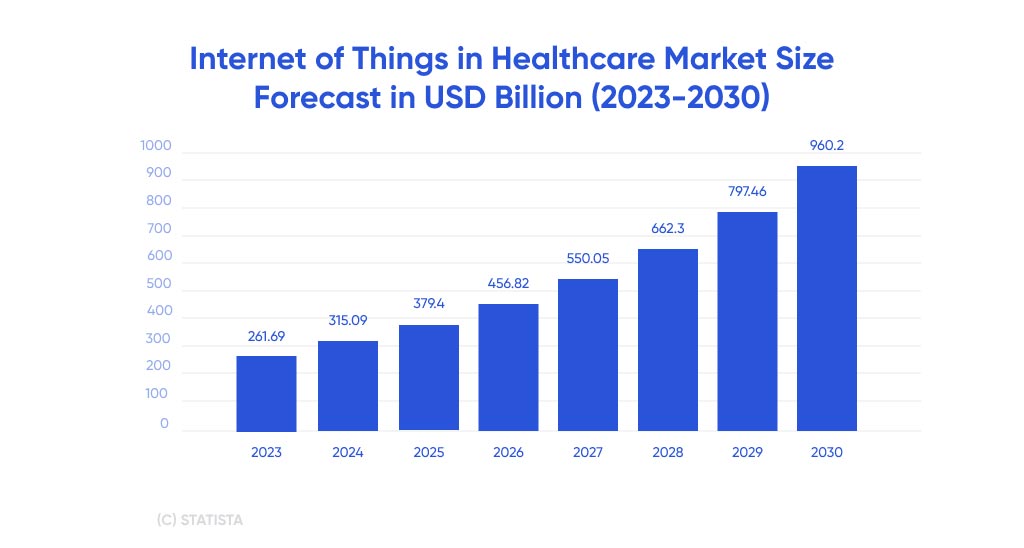
- Complex web software to boost user engagement
Nowadays, requirements for healthcare website development have become more complex. One of the reasons behind this phenomenon is the audience’s desire to get that “all-inclusive” experience. No one wants to surf the Internet for hours looking for all kinds of relevant medical info, and comprehensive healthcare web apps help to avoid that.
Patients are now accustomed to getting diagnosed online, scheduling appointments, and buying meds using a laptop, a PC, a tablet, or a smartphone. A multifunctional web-based medical portal allows the user to do all that (and much more) with only a couple of clicks. So no wonder the demand for extensive healthcare web solutions will remain high for a long period of time.
- Telemedicine
Last but certainly not least is the telemedicine trend. Once the pandemic hit, the global population was literally forced to pay more attention to telemedicine and healthcare services provided online. And many were pleasantly surprised by how convenient and effective this practice might be.
One of the most important aspects from the business perspective is telemedicine’s longevity. Even if Covid-19 is no longer a threat to humanity, medical consultations online will still be sought-after by a large audience (e.g., people suffering from chronic conditions, first-time parents, disabled people, etc.)
Keep in mind that there are dozens of healthcare IT trends out there. For example, predictive modeling in healthcare and Data Mining in the healthcare are the ones worth mentioning. However, in this particular editorial, we’ve tried to focus solely on the most popular tendencies with maximum outreach.
The most popular types of healthcare software
Healthcare web development and medical software truly come in all imaginable forms. Name any healthcare-related task, and there will be some kind of digital solution for it. At least several hours will be needed to briefly describe all of them.
To save you precious time, we will focus on five of the most popular types of medical software you might consider developing.
- EHR/EMR
EHR/EMR system is by far the most popular type of healthcare software in 2023. And there’s no surprise there. EHR solutions simplify and automate almost all kinds of medical tasks (from patients’ records tracking to data exchange and invoicing). So no wonder healthcare business owners choose to get one sooner or later.
It is also worth mentioning that EHR/EMR adoption process is far from over. In fact, research by Insight Partners predicts the global EHR market growth at least until 2028.
- Telemedicine
In this editorial, we’ve already mentioned how keen the patients are to explore the opportunities telemedicine platforms offer. And a great thing from a business perspective is that telemedicine functionality can be executed differently depending on the customer’s needs. It might be just a video conference function or a video call accompanied by a bunch of other communication tools like voice chat, text chat, and multimedia exchange.
- Patient-centric apps
This type of healthcare software is probably one of the most diverse. As the name suggests, such solutions are all about the patient’s needs. This type of software is known to give the patient the most control over the healthcare process.
Think about personal health-tracking apps, symptom checkers, fitness and wellness platforms, online medical assistants, dieting apps, etc. All these solutions help the patient be proactive and get their health under control without being too restrictive. Such a combination of usability, efficiency, and freedom ensures the software’s popularity among the general public.
- Medical training and education software
Regular training keeps medical professionals well-prepared and significantly reduces the number of mistakes. That is why so many healthcare businesses nowadays opt for medical LMS development. A learning management system development may seem excessive at first, but in reality, this step is able to bring any healthcare company multiple benefits.
An LMS for health workers is able to increase the quality of the services provided, enhance the communication between staff members, boost brand loyalty, and improve the team environment.
- Healthcare ecosystems
Complex “all-in-one” software systems and solutions like HMS allow to easily manage all the processes within even the largest medical facilities. Such healthcare ecosystems are typically feature-packed and include various functionality. They often combine EHR, CRM, and telemedicine functionality with medical billing, tracking and monitoring features, asset management, and medical imaging software.
However, it doesn’t stop there! As such healthcare ecosystems are always custom, the list of features available for implementation may include almost any IT innovation the industry has to offer.
How to Develop a Healthcare Web app?
Certain entrepreneurs are 100% positive that healthcare web app development (or website development) is not their responsibility. They’re positive that it’s more than enough to choose a technical team and put them in the driving seat.
Such an approach is not the most beneficial one as it makes a customer fully dependent on the contractor. That is why a business owner should know about the main stages of the development process to have better control over the workflow.
Initial contact
Technically speaking, the first stage may be the last one if the chosen contractor makes you raise your eyebrow from day one. Remember that until both parties have signed a contract, a business owner is free to change their mind and select another tech partner.
During the initial stage, an entrepreneur shares available information about their vision as well as existing documentation (if any). The provider, in its turn, creates a ballpark estimation for the project and presents it to the client. If the customer is satisfied, the contract and an NDA are signed. After this, the parties proceed to the discovery stage.
Discovery
The discovery stage is the phase of information collection and requirements formation. There are several types of requirements necessary for a successful web development process: business, stakeholder, functional, non-functional, design, and integration.
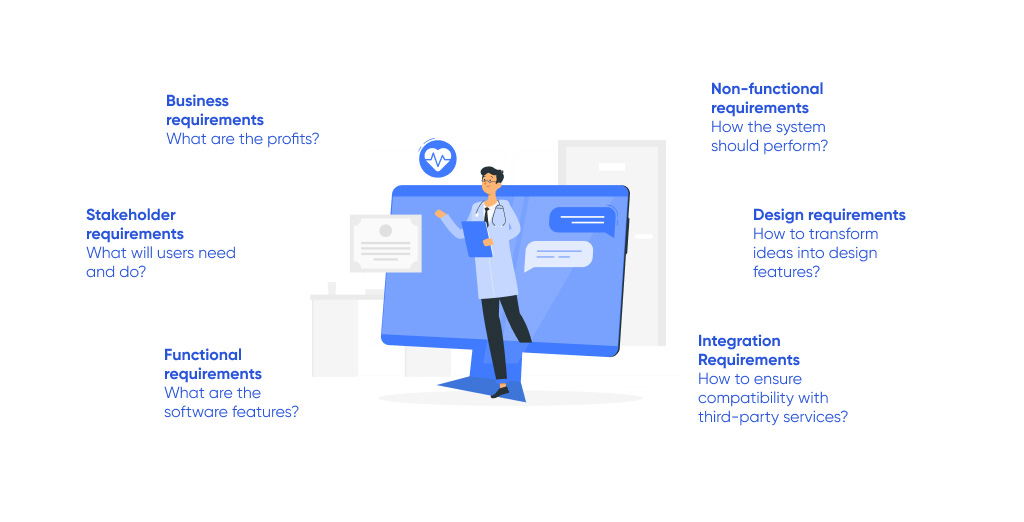
This is also time to discuss all the project’s specifics and come up with a detailed implementation plan. Things like compliance and interoperability must definitely be brought up. It’s nice for a business owner to have at least some kind of supporting materials (e.g., a HIPAA compliance checklist) to simplify the communication process with the technical experts.
Design
The design of a modern web solution is not just about making it look pretty and choosing the right color scheme. Even though graphic design and brand identity are necessary, impeccable UI/UX is even more important.
The experts will come up with a user-friendly interface where each element is placed strategically to accommodate the user’s needs and typical behavior. The goal here is to safeguard uninterrupted user experience, lead the audience towards the desired action (e.g., book an appointment), and form a positive brand image.
The wireframes, prototypes, and screens will be prepared for different types of devices (even mobile ones), as modern healthcare web solutions should have an adaptive design and be available via any device.
Development
This is when all the requirements mentioned above are transformed into lines of code and an actual digital solution. Typically this stage is broken down into smaller steps — sprints — each one implying the delivery of a specific piece of functionality.
The development process includes front- and back-end development as well as data migration and third-party services integration (if needed).
Testing
Professional quality assurance is crucial for healthcare website development and app development as security and performance standards are extremely high. During this stage, QA engineers typically work with the dev team. They carefully test all the aspects of the system, create bug reports, send those to the developers, and test once again to secure flawless system operation.
Launch
This is when a newly developed solution becomes available to the general public. The provider makes sure all the systems work properly on the live server. If the customer is happy with the result, the contractor hands over the system to the business owner (including all the documentation).
Maintenance
Each digital solution requires constant support and maintenance. Regular security checks and updates, bug fixing and performance enhancement, adding new features per customer’s request and new third-party services integration are just a few examples of possible tasks for a tech team. The business owner should have someone to take care of any possible IT challenges that may appear along the way.
Key software features to consider during healthcare web development
One of the greatest assets of custom healthcare web development is creative freedom. Literally, any idea can be brought to life if the tech team is given enough time and resources. Yet, some business owners may perceive such flexibility as a burden simply because they do not have enough experience to determine which software functionality is vital for the project’s future success and which is not that necessary.
To make this process easier, we’ve created a list of top-10 healthcare software features divided into two tears: mandatory and optional.
Top five mandatory healthcare software features
Today, medical software users are no longer inexperienced and enraptured. People have mastered technology and can tell poorly executed digital solutions from neat ones. The audience tries out new healthcare-related platforms already having a certain level of expectations the product has to meet. And if the solution fails to make that good first impression, the chances are the audience is leaving and never coming back.
So how not to fail the customers’ trust? It’s essential to think out the platform’s functionality and include the following five features in the healthcare web development plan.
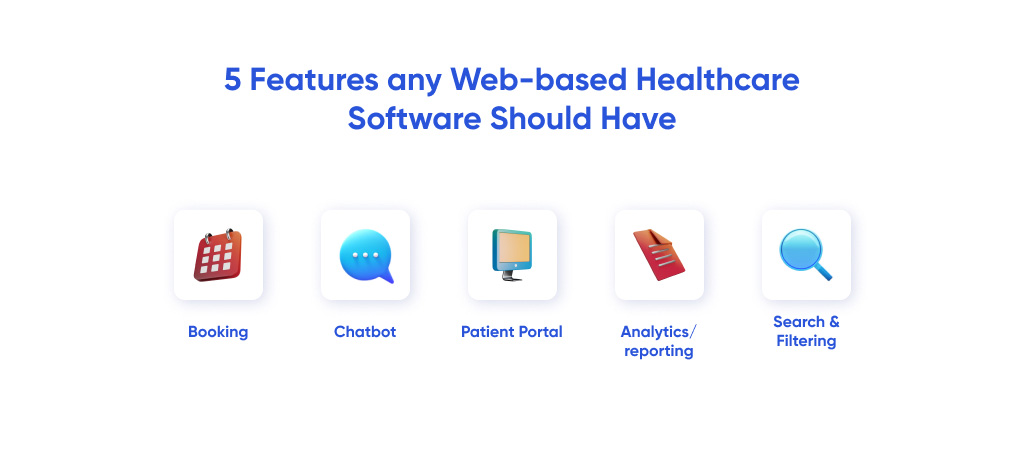
Booking
Whether you own a certain type of medical facility, want to create a web platform to facilitate your private practice, or plan to sell some kind of products online, you should consider incorporating some kind of booking functionality into your solution.
The audience usually doesn’t want to put in some extra work and call or email the business owner. So it’s better to create a way for the customer to schedule an appointment with just a few clicks.
Chatbot
Customers need help when they need it, which is 24/7. And being there for your audience is especially important in healthcare. Providing that around-the-clock customer support might be challenging for smaller companies, but there’s a simple and effective solution — a chatbot.
Modern chatbots can not only answer the most common questions users have, but they also may help patients schedule appointments, check for symptoms, or even file claims. The software’s functionality may vary depending on the project’s specifics.
Patient Portal
The medical industry constantly operates the most sensitive personal data. That is why security and interoperability in healthcare are such a big deal. And that is also a reason why customers prefer to have a little bit more privacy than usual.
One of the most efficient and safe ways to do that is to create a patient portal with access to it for registered users only. The functionality of said portal may vary from one project to another, yet the principle “the more useful features, the better” definitely works here. The business owner may consider incorporating a knowledgebase or a media library, a video chat, a history of visits/purchases, a payment gateway, file upload/download functionality, and many other tools the audience may find necessary.
Analytics/reporting
There’s not much to say about the importance of analytics and reporting functionality in healthcare web development except for the fact that it directly influences both the workflow and the project’s commercial success.
Medical professionals utilize analytics and reporting to improve the quality of care, avoid mistakes, eliminate bottlenecks, and diagnose patients faster and more accurately. Marketing professionals, on the other hand, use this kind of functionality to receive valuable insights which help to detect possible drawbacks and enhance the user experience. By rejecting analytics and reporting, an entrepreneur willingly complicates the management process to the point it becomes worthless.
Search & Filtering
One of the important aspects to consider during a healthcare web app development process is simple and intuitive navigation. Users always want to get to the relevant info they’re searching for as faster as possible. And for healthcare solutions, this principle is especially important as someone’s life may depend on the speed and accuracy of data processing.
Make sure to introduce an extensive yet simple search and filtering system to your solution. For example, allow the users to search not only by a keyword but also by category or a specific time period. Making this happen will take effort both from the designers and the developers but creating a flawless user experience always pays off eventually.
Top five optional (but beneficial) healthcare software features
The diversity and heterogeneity of the eHealth market often complicate the process of functionality prioritizing. If the feature is absolutely essential for one solution, it doesn’t mean it will bring any use to another project. Still, there are some elements that work for the majority of healthcare websites or web apps and which should definitely be considered by a business owner.
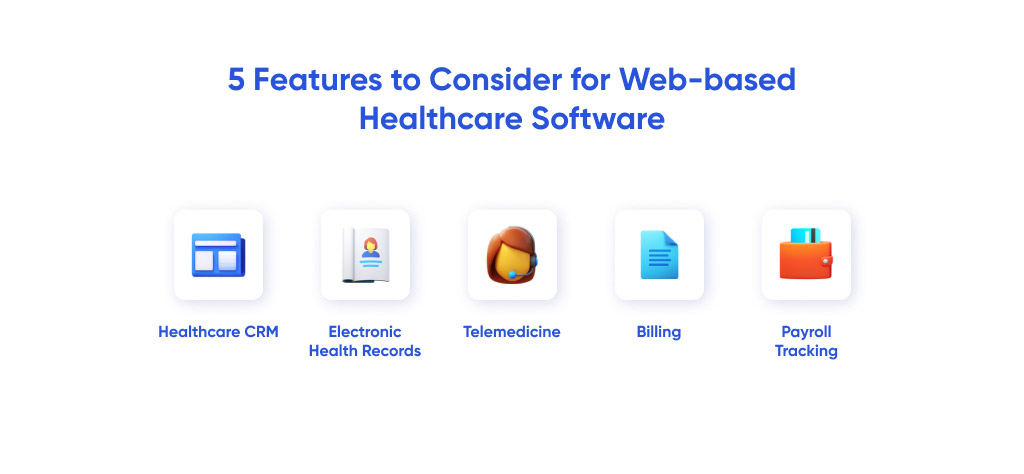
Healthcare CRM
There’s a “golden rule” stating that a successful business should know its customers. The healthcare business is no exception in this regard. And what better way to build fruitful relations with patients than investing in a healthcare CRM?
This type of software will help the staff create an excellent personalized medical care experience for the customers, develop sustainable patient interaction strategies, reduce administrative overhead, boost customers’ loyalty, maximize marketing efficiency, and deal with a bunch of other challenges.
Electronic Health Records
EHR Software Development is on the rise right now. Increased productivity, better security, lower risk of malpractice, improved data and document processing, smooth communication, and other assets just can’t be ignored by businesses willing to get that competitive edge.
IT market offers cheaper, less functional out-of-the-box systems and modern custom software. This provides entrepreneurs with the liberty of choice and the ability to gradually scale the existing solution adapting to the requirements of the market and the audience.
Telemedicine
There’s no denying that telemedicine has a bright future. People want to use this kind of service and often are even specifically looking for healthcare providers offering robust online consultations.
Incorporating telemedicine functionality into healthcare website development or web app development plan will require quite a few resources, but the effort a business owner is willing to invest will pay off in the form of the audience’s interest and increased brand loyalty.
Billing
Managing all types of financial tasks is one of the most tedious yet important processes for any healthcare business. So no wonder many entrepreneurs rely on technological advancements to help them simplify and optimize billing and invoicing.
The main reason why this feature is among the “optional” and not “mandatory” ones is that some businesses already have a specific third-party billing service and do not require developing it from scratch. However, if you do not have one yet, consider taking care of it during the healthcare web development process.
Payroll Tracking
It’s hard to overestimate the importance of payroll tracking and management for any successful healthcare business. There are plenty of KPIs to keep an eye on, and manual methods do not ensure the same level of efficiency as digital solutions.
Simplify calculations and payslip generation, minimize errors, keep a record of working hours, and manage taxes and compensation expenses all at once. Custom payroll tracking software can make it happen.
Factors influencing the cost of a healthcare web solution
The matter of healthcare web development pricing is complex and tricky, as different IT providers may offer vastly different costs for the same services. And the reason for that is a multitude of factors directly influencing the price. Let’s examine the most important ones.
- Development approach
There are several ways to create a fully-functional healthcare web solution. The cheapest and the fastest one is opting for out-of-the-box software. Open-source platforms can be used for different purposes: EHR, e-prescribing, CRM, HSE management, and many others. The process is simple: a business owner chooses a suitable solution, then pays a fixed fee (one-time, monthly, yearly, etc.), and sets up the software. The price typically ranges from several hundred to a couple of thousands of dollars, depending on the offered functionality.
However, choosing this kind of software is usually not the smartest strategy in the long run, as out-of-the-box systems lack flexibility and scalability. Sooner or later, an entrepreneur hits a glass ceiling and is forced to switch to a custom-made healthcare web solution.
Custom healthcare web development takes more time and is more expensive, yet in the end, the customer receives a system that fully meets all the company’s business needs and checks all the boxes at once.
The choice between cloud and on-premise software also shapes the cost. Most businesses choose cloud solutions as they are cheaper, faster, and ensure project scalability.
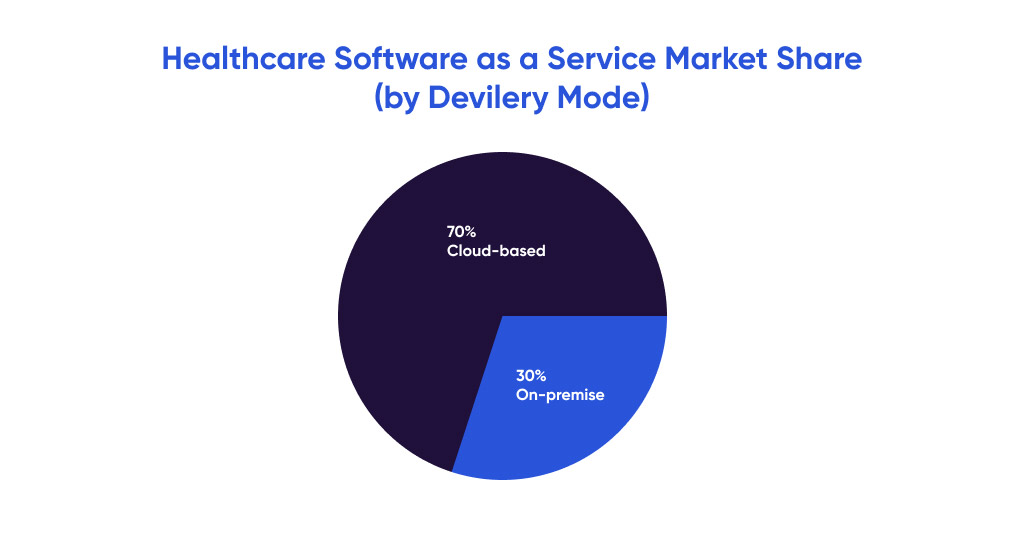
- Technical team’s structure and location
Healthcare web development is a complex process that requires teamwork and the involvement of multiple experts: business analysts, managers, designers, developers, and QA engineers.
One of the ways a business owner may navigate the situation is to build an in-house team. In this case, the development crew will be formed by local specialists, and the customer will ensure maximum control over each software creation step. However, the entrepreneur should be ready to pay not only for the development itself but also for the staff’s insurance, sick leaves, hardware, and office rent, as well as for other expenditures.
A great alternative to an in-house team is outsourcing. If this option is chosen, the team will work remotely, but the overall price will be much lower, and the business owner will have access to a much wider pool of talents as the search for a suitable provider will no longer be limited to a certain city or even country.
The tech team’s location also influences the price directly. Some regions are known to offer affordable software development rates while guaranteeing good quality of the final product.
Take a look at average hourly rates in different parts of the world:
- North America USD 75-150
- Western Europe USD 55-200
- Latin America USD 35-60
- Eastern Europe USD 25-45
- Asia USD 22-40
- Project’s complexity
It is common for healthcare web development to utilize a time and material model, which means that the customer pays for the hours spent on building the software. Consequently, the project’s complexity and the number of features requiring implementation will influence the development price directly. Higher complexity equals more development time and, as a result, higher cost.
- Time to market
Each software development project is unique, and there are times when it’s crucial to create and launch the platform ASAP or meet a certain deadline (e.g., an industry-specific event).
The tighter this time period is, the higher the cost will be, as the team will have to come up with ways to meet the customer’s requirements. It might be team augmentation or working extra hours. Either way, the cost will increase.
Note that there are also other factors that may change the cost. We’re talking about the use of certain technologies, design complexity, an array of post-launch services, etc. However, the price fluctuation, in this case, will not be as drastic.
How to Choose a Perfect Healthcare Web Development Team
A well-assembled technical team is essential for building a solid marketable healthcare digital solution. While choosing a contractor or hiring an in-house team, an entrepreneur should keep a close watch on multiple aspects that will guarantee a smooth cooperation experience.
- Team structure
As mentioned earlier, healthcare website development, as well as web app development, is not something a single person can deliver. It must be a team effort, and the team should be well-rounded and well-equipped.
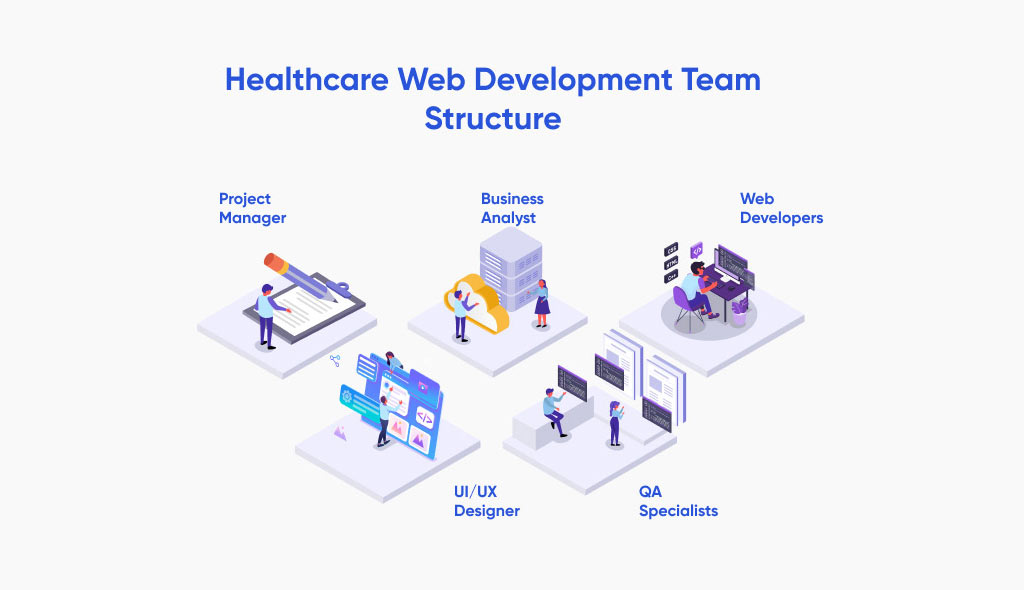
The number of specialists may vary, but certain experts must be present to safeguard the product’s quality. Who those experts are? Make sure your team has a business analyst, a project manager, front- and back-end developers, designers (graphic and UI/UX), and QA engineers.
You might also want to include a team lead (if the project is particularly technically challenging), a DevOps expert or mobile developers (if you want to also invest in healthcare mobile app development).
If a contractor is willing to provide you with all of those experts, it is worth considering. If not, it’s better to keep looking for a better option.
- Multiple communication channels
This aspect is especially important if an entrepreneur plans on outsourcing healthcare web development. It’s ok if there’s only one preferred communication channel (e.g., a messenger or email), but it’s sensible to have a backup just in case. A reliable technological partner will always give the customers several options.
- Relevant portfolio
Nothing proves a high level of expertise better than a portfolio. Ask a potential contractor for examples of web-based healthcare projects that were developed by them. Ideally, the portfolio should include projects that have the same functionality that you plan to include. If the portfolio is not relevant (e.g., includes only software created for other business niches) or doesn’t exist at all, it’s a huge red flag that can’t be ignored.
- Overall openness
It should be easy for the client to find information about a potential IT provider. Customer reviews, a fully-functioning website, solid social media presence, quick feedback… All that matters. If the chosen contractor is a “dark horse” with minimum to no available information about their business, you probably should consider someone else.
Bonus Infographic
As a cherry on top, we’ve created an infographic that contains several interesting facts and statistics on the state of the modern healthcare business. Enjoy!
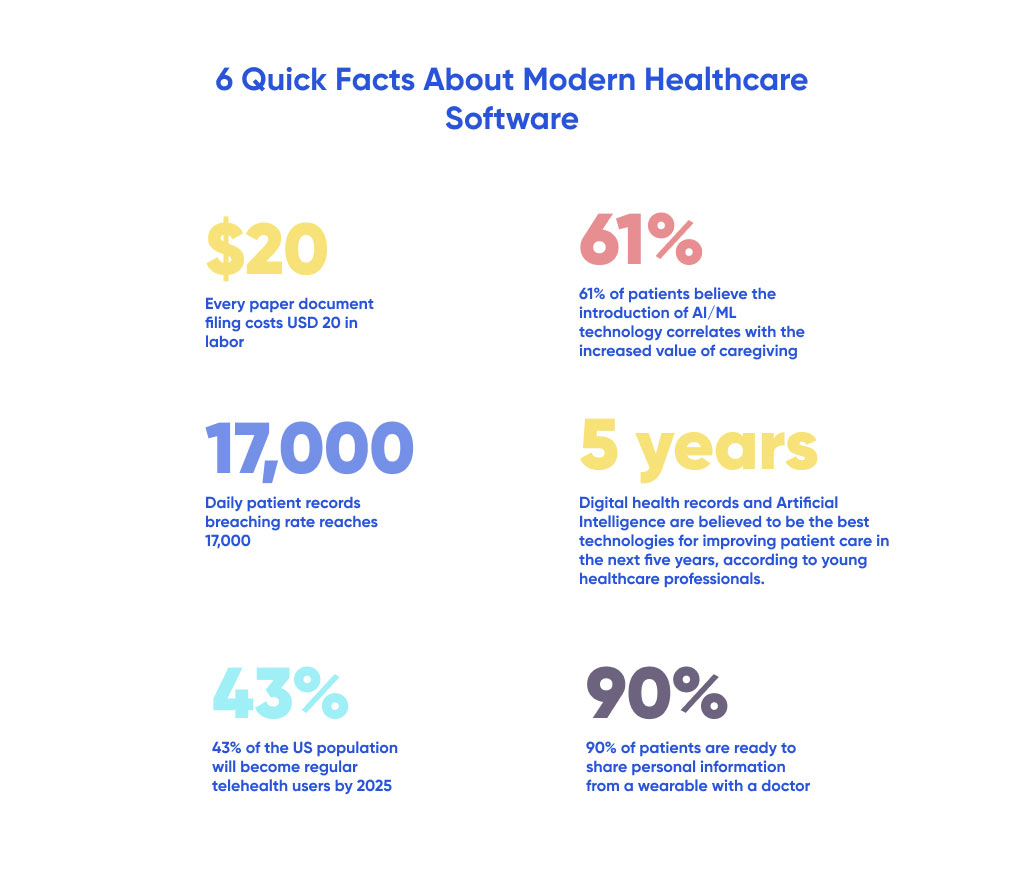
Final words
Healthcare web development can become a springboard for your business. However, to maximize the chances for future success, the process should be taken seriously. If you’re looking for an experienced IT partner that will not let you down, contact Light IT Global! We’re ready to answer all your questions and provide you with a free estimation for your project. Maybe it will become the beginning of your success story?

